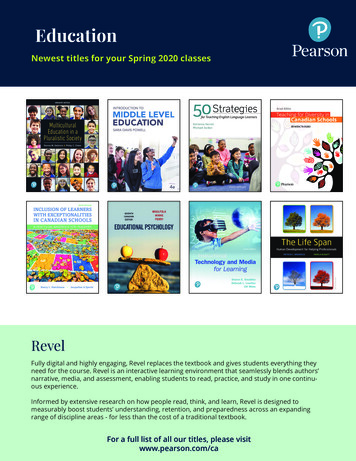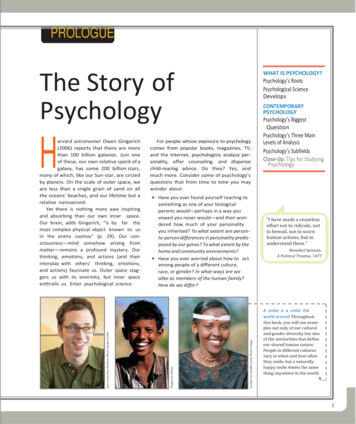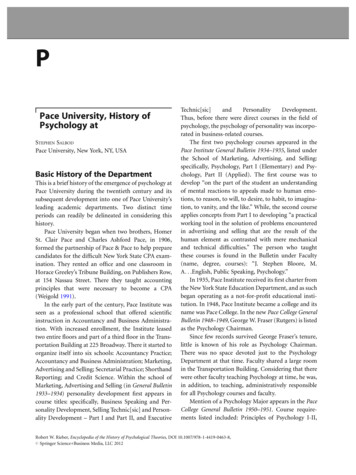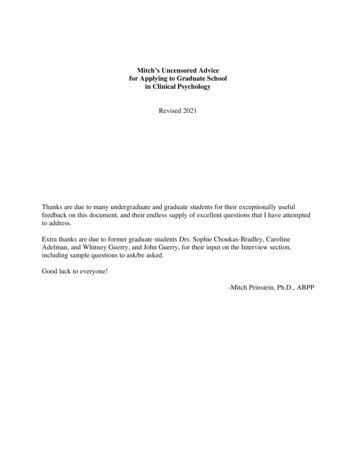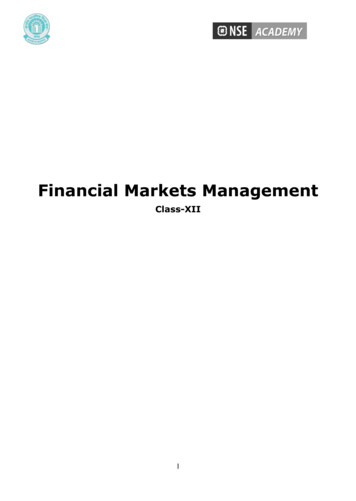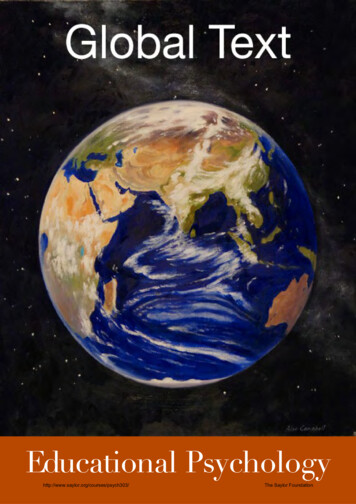
Transcription
Educational he Saylor Foundation
This book is licensed under a Creative Commons Attribution 3.0 LicenseEducational PsychologySecond EditionKelvin Seifert and Rosemary SuttonCopyright 2009 Kelvin SeifertFor any questions about this text, please email: drexel@uga.eduEditor-In-Chief: Kelvin SeifertAssociate Editor: Marisa DrexelEditorial Assistant: Jackie SharmanProofreader: Rachel PuglieseThe Global Text Project is funded by the Jacobs Foundation, Zurich, SwitzerlandThis book is licensed under a Creative Commons Attribution 3.0 LicenseEducational A Global TextThe Saylor Foundation
This book is licensed under a Creative Commons Attribution 3.0 LicenseAbout the authors and reviewerAuthor, Kelvin SeifertKelvin Seifert is professor of educational psychology at the University of Manitoba, Winnipeg, Canada. Heearned a BA from Swarthmore College in 1967 and a PhD from the University of Michigan in 1973, in a combinedprogram from the School of Education and the Department of Psychology. His research interests include thepersonal identity development of teachers, the impact of peers in 0pre-service teacher education, and thedevelopment of effective strategies of blended learning. He is the author of four university textbooks (withHoughton Mifflin, in traditional print format) about educational psychology, child and adolescent development,and lifespan human development. He is also the editor of the online Canadian Journal of EducationalAdministration and Policy. Recent publications include “Student cohorts: Support groups or intellectualcommunities?” (Teachers College Record) and “Learning about peers: A missed opportunity for educationalpsychology” (The Clearinghouse). His professional service includes serving as chair of the Department ofEducational Administration, Foundations, and Psychology at the University of Manitoba, and serving as presidentof the American Educational Research Association Special Interest Group on Teaching Educational Psychology.During his career of 35 years, he has taught introductory educational psychology over 75 times.Author, Rosemary SuttonAfter four years of teaching high school mathematics in New Zealand, Dr Rosemary Sutton attended graduateschool and earned her MS in Educational Psychology from the University of Illinois and her PhD from PennsylvaniaState University in Human Development. She joined the Cleveland State University faculty in Cleveland, Ohio in1983 and since that time has taught pre-service and in service undergraduates and graduate students educationalpsychology and educational technology. She has received several University awards for her teaching and hasconducted numerous workshops for teachers in North East Ohio.Dr Sutton has published a variety research articles on teacher development as well as equity issues inmathematics, technology, and assessment. Her recent research interests have focused in two areas: teachingeducational psychology and teachers' emotions. Recent publications can be found in Social Psychology ofEducation, Educational Psychology Review, Journal of Teacher Education, and an edited volume, Emotions andEducation.Since 2004, Dr Sutton has been working as an Administrator, first as the Director of Assessment for theUniversity. This position involved coordinating the student learning assessment for all graduate, undergraduate,and student support programs. In August 2007, Dr Sutton was appointed Vice Provost for Undergraduate Studiesand is now responsible for overseeing offices and functions from academic and student service areas in order tocreate a campus culture that coordinates student services with the academic mission of the University.Reviewer, Sandra DeemerSandra Deemer is professor of educational foundations at Millersville University, in Millersville, PA. She is alsothe editor of the online journal called "Teaching Educational Psychology," and has contributed to the developmentof the Special Interest Group on Teaching Educational Psychology (TEP SIG) sponsored by the AmericanEducational Research Association. She teaches courses in educational psychology and educational research; herresearch interests focus on how motivational theory can be used to create learning-focused classrooms.Educational A Global TextThe Saylor Foundation
Table of ContentsPreface. 71. The changing teaching profession and you.8The joys of teaching. 8Are there also challenges to teaching?.10Teaching is different from in the past. 10How educational psychology can help.162. The learning process .20Teachers’ perspectives on learning. 20Major theories and models of learning. 233. Student development. 41Why development matters. 42Physical development during the school years. 43Cognitive development: the theory of Jean Piaget. 46Social development: relationships,personal motives, and morality .50Moral development: forming a sense of rights and responsibilities. 56Understanding “the typical student” versus understanding students. 614. Student diversity.66Individual styles of learning and thinking. 67Multiple intelligences. 68Gifted and talented students. 70Gender differences in the classroom. 72Differences in cultural expectations and styles. 75Accommodating diversity in practice. 805. Students with special educational needs. 85Three people on the margins.85Growing support for people with disabilities: legislation and its effects. 86Responsibilities of teachers for students with disabilities.87Categories of disabilities—and their ambiguities. 91Learning disabilities.91Attention deficit hyperactivity disorder. 94Intellectual disabilities. 96Behavioral disorders.99Physical disabilities and sensory impairments.101The value of including students with special needs. 1046. Student motivation. 109Motives as behavior.110Motives as goals. 113Motives as interests. 116Motives related to attributions.118Motivation as self-efficacy. 120Motivation as self-determination. 125Expectancy x value: effects on students’ motivation.130TARGET: a model for integrating ideas about motivation. 1317. Classroom management and the learning environment. 138Why classroom management matters. 1394http://www.saylor.org/courses/psych303/The Saylor Foundation
This book is licensed under a Creative Commons Attribution 3.0 LicensePreventing management problems by focusing students on learning.140Responding to student misbehavior.150Keeping management issues in perspective. 1558. The nature of classroom communication.159Communication in classrooms vs communication elsewhere. 159Effective verbal communication. 162Effective nonverbal communication.163Structures of participation: effects on communication.166Communication styles in the classroom.169Using classroom talk to stimulate students’ thinking. 172The bottom line: messages sent, messages reconstructed. 1769. Facilitating complex thinking.183Forms of thinking associated with classroom learning.184Critical thinking. 185Creative thinking .186Problem-solving. 187Broad instructional strategies that stimulate complex thinking. 191Teacher-directed instruction. 193Student-centered models of learning. 200Inquiry learning. 201Cooperative learning. 202Examples of cooperative and collaborative learning. 203Instructional strategies: an abundance of choices.20510. Planning instruction. 210Selecting general learning goals. 210Formulating learning objectives. 215Students as a source of instructional goals. 223Enhancing student learning through a variety of resources.226Creating bridges among curriculum goals and students’ prior experiences. 229Planning for instruction as well as for learning. 23511. Teacher-made assessment strategies. 240Basic concepts. 241Assessment for learning: an overview of the process.241Selecting appropriate assessment techniques I: high quality assessments.243Reliability . 245Absence of bias . 246Selecting appropriate assessment techniques II: types of teacher-made assessments.246Selected response items.249Constructed response items . 254Portfolios.264Assessment that enhances motivation and student confidence. 267Teachers’ purposes and beliefs . 267Choosing assessments . 268Providing feedback . 268Self and peer assessment . 269Adjusting instruction based on assessment. 270Communication with parents and guardians.270Educational A Global TextThe Saylor Foundation
Action research: studying yourself and your students. 271Grading and reporting . 27212. Standardized and other formal assessments.277Basic concepts. 277High-stakes testing by states.283International testing. 291International comparisons . 292Understanding test results. 292Issues with standardized tests .298Appendix A: Preparing for licensure. 304Appendix B: Deciding for yourself about the research.319Appendix C: The reflective practitioner. 351Types of resources for professional development and learning. 352Reading and understanding professional articles .355Action research: hearing from teachers about improving practice. 366The challenges of action research. 371Benefiting from all kinds of research. 3736http://www.saylor.org/courses/psych303/The Saylor Foundation
This book is licensed under a Creative Commons Attribution 3.0 LicensePrefaceDr. Kelvin Seifert: Why I wanted this book to be part of the Global Textbook ProjectI have taught educational psychology to futureteachers for nearly 35 years, during which I used one oranother of the major commercial textbooks written forthis subject. In general I found all of the books wellwritten and thorough. But I also found problems:(1) Though they differed in details, the majortextbooks were surprisingly similar in overall coverage.This fact, coupled with their large overall size, made ithard to tailor any of the books to the particular interestsor needs of individuals or groups of students. Too often,buying a textbook was like having to buy a huge Sundaynewspaper when all you really want is to read one of itssections. In a similar way, commercial educationalpsychology textbooks usually told you more than youever needed or wanted to know about the subject. As aformat, the textbook did not allow for individualization.Dr. Kelvin Seifert(2) Educational psychology textbooks were alwaysexpensive, and over the years their costs rose faster than inflation, especially in the United States, where most of thebooks have been produced. Currently every major text about educational psychology sells for more than USD 100.At best this cost is a stress on students' budgets. At worst it puts educational psychology textbooks beyond the reachof many. The problem of the cost is even more obvious when put in worldwide perspective; in some countries thecost of one textbook is roughly equivalent to the average annual income of its citizens.(3) In the competition to sell copies of educational psychology textbooks, authors and publishers have graduallyadded features that raise the cost of books without evidence of adding educational value. Educational psychologypublishers in particular have increased the number of illustrations and photographs, switched to full-color editions,increased the complexity and number of study guides and ancillary publications, and created proprietary websitesusable fully only by adopters of their particular books. These features have sometimes been attractive. My teachingexperience suggests, however, that they also distract students from learning key ideas about educational psychologyabout as often as they help students to learn.By publishing this textbook online with the Global Textbook Project, I have taken a step toward resolving theseproblems. Instructors and students can access as much or as little of the textbook as they really need and finduseful. The cost of their doing is minimal. Pedagogical features are available, but are kept to a minimum andrendered in formats that can be accessed freely and easily by anyone connected to the Internet. In the future,revisions to the book will be relatively easy and prompt to make. These, I believe, are desirable outcomes foreveryone!--Kelvin SeifertEducational A Global TextThe Saylor Foundation
This book is licensed under a Creative Commons Attribution 3.0 License1. The changing teachingprofession and youA teacher named Ashley reflects: She looked around the classroom, enjoying a blessed moment ofquiet after the students left at the end of the day. “Ashley, the teacher, that’s me”, she said proudly tothe empty room. “But why am I doing this?” she asked herself quietly—and realized she wasn’talways sure of the answer. But then she remembered one reason: she was teaching for Nadia, whosat at the table to the left, always smiled so well and always (well, usually) tried hard. And anotherreason: she was teaching for Lincoln, tired old Lincoln, who needed her help more than he realized.She remembered twenty other reasons—twenty other students. And one last reason: she was alsoteaching for herself, challenging herself to see if she really could keep up with twenty-two youngpeople at once, and really accomplish something worthwhile with them. She was teaching so shecould keep growing as a person, keep connecting with others, keep learning new ideas. That’s whyshe was teaching.The joys of teachingWhy be a teacher? The short answer is easy: to witness the diversity of growth in young people, and their joy in learning to encourage lifelong learning—both for yourself and for others to experience the challenge of devising and doing interesting, exciting activities for the youngThere is, of course, more than this to be said about the value of teaching. Consider, for instance, the “youngpeople” referred to above. In one class they could be six years old; in another they could be sixteen, or even older.They could be rich, poor, or somewhere in between. They could come from any ethnic background. Their firstlanguage could be English, or something else. There are all sorts of possibilities. But whoever the particularstudents are, they will have potential as human beings: talents and personal qualities—possibly not yet realized—that can contribute to society, whether as leaders, experts, or supporters of others. A teacher's job—in fact ateacher's privilege—is to help particular “young people” to realize their potential.Another teacher reflects: Nathan paused for a deep breath before speaking to me. “It’s not like Iexpected it to be,” he said. “I’ve got five kids who speak English as a second language. I didn’t expectthat. I’ve got two, maybe three, with reading disabilities, and one of them has a part-time aide. I’vehad to learn more about using computers than I ever expected—they’re a lot of curriculum materialsonline now, and the computers help the kids that need more practice or who finish activities early.I’m doing more screening and testing of kids than I expected, and it all takes time away fromteaching.Educational A Global TextThe Saylor Foundation
1. The changing teaching profession and you“But it’s not all surprises. I expected to be able to ‘light a fire’ under kids about learning to read. Andthat has actually happened, at least sometimes with some children!”As a teacher, you will be able to do this by laying groundwork for lifelong learning. You will not teach any onestudent forever, of course, but you will often work with them long enough to convey a crucial message: that there ismuch in life to learn—more in fact than any one teacher or school can provide in a lifetime. The knowledge may beabout science, math, or learning to read; the skills may be sports, music, or art—anything. Whatever you teach, itsimmensity can be a source of curiosity, wonder and excitement. It can be a reason to be optimistic about life ingeneral and about your students in particular. Learning, when properly understood, is never-ending, even though itoften focuses on short-term, immediate concerns. As a teacher, you will have an advantage not shared by everymember of society, namely the excuse not only to teach valuable knowledge and skills, but to point students beyondwhat they will be able to learn from you. As an old limerick put it (before the days of gender-balanced language),“The world is full of such a plenty of things, I’m sure we should all be as happy as kings.”Jennifer Fuller, a third teacher reflects: “OK”, suddenly getting businesslike in her tone. “Here’s mytypical day teaching tenth grade: I get up at 6:30, have a quick breakfast, get to school by 7:45 if thetraffic’s not bad. Then I check my email—usually there’s a little stuff from the principal or some otheradministrator, maybe one or two from parents concerned because their child is doing poorly in oneof my classes, maybe one or two from students—“I’m going to be sick today, Ms Fuller!”—that sort ofthing. Now it’s 8:15 and I have two hours before my first class—this term I teach only biology, and Ionly teach periods 2, 3, and 5. Maybe I have marking to do before class, or maybe I have to get a labdemonstration ready. Or maybe we all have to troupe down to the library for a staff meeting(groan ). Whatever I don’t finish in the morning, I have to finish after school. But that’s also when Imeet with the Ecology Club (I’m the faculty advisor), so I might have to finish stuff in the evening. Itry not to do it then, but a lot of times I have to. But I always quit by 9:00—that’s always when Iwatch TV for an hour, or just “vegetate ” with a book.”Whatever you teach, you will be able to feel the satisfaction of designing and orchestrating complex activitiesthat communicate new ideas and skills effectively. The challenge is attractive to many teachers, because that iswhere they exercise judgment and “artistry” the most freely and frequently. Your students will depend on your skillat planning and managing, though sometimes without realizing how much they do so. Teachers will need you toknow how to explain ideas clearly, to present new materials in a sensible sequence and at an appropriate pace, topoint out connections between their new learning and their prior experiences. Although these skills really take alifetime to master, they can be practiced successfully even by beginning teachers, and they do improve steadily withcontinued teaching over time. Right from the start, though, skill at design and communication of curriculum is oneof the major “perks” of the job.The very complexity of classroom life virtually guarantees that teaching never needs to get boring. Somethingnew and exciting is bound to occur just when you least expect it. A student shows an insight that you neverexpected to see—or fails to show one that you were sure he had. An activity goes better than expected—or worse, ormerely differen
development of effective strategies of blended learning. He is the author of four university textbooks (with Houghton Mifflin, in traditional print format) about educational psychology, child and adolescent development, and lifespan human development. He is also the editor of the online C



